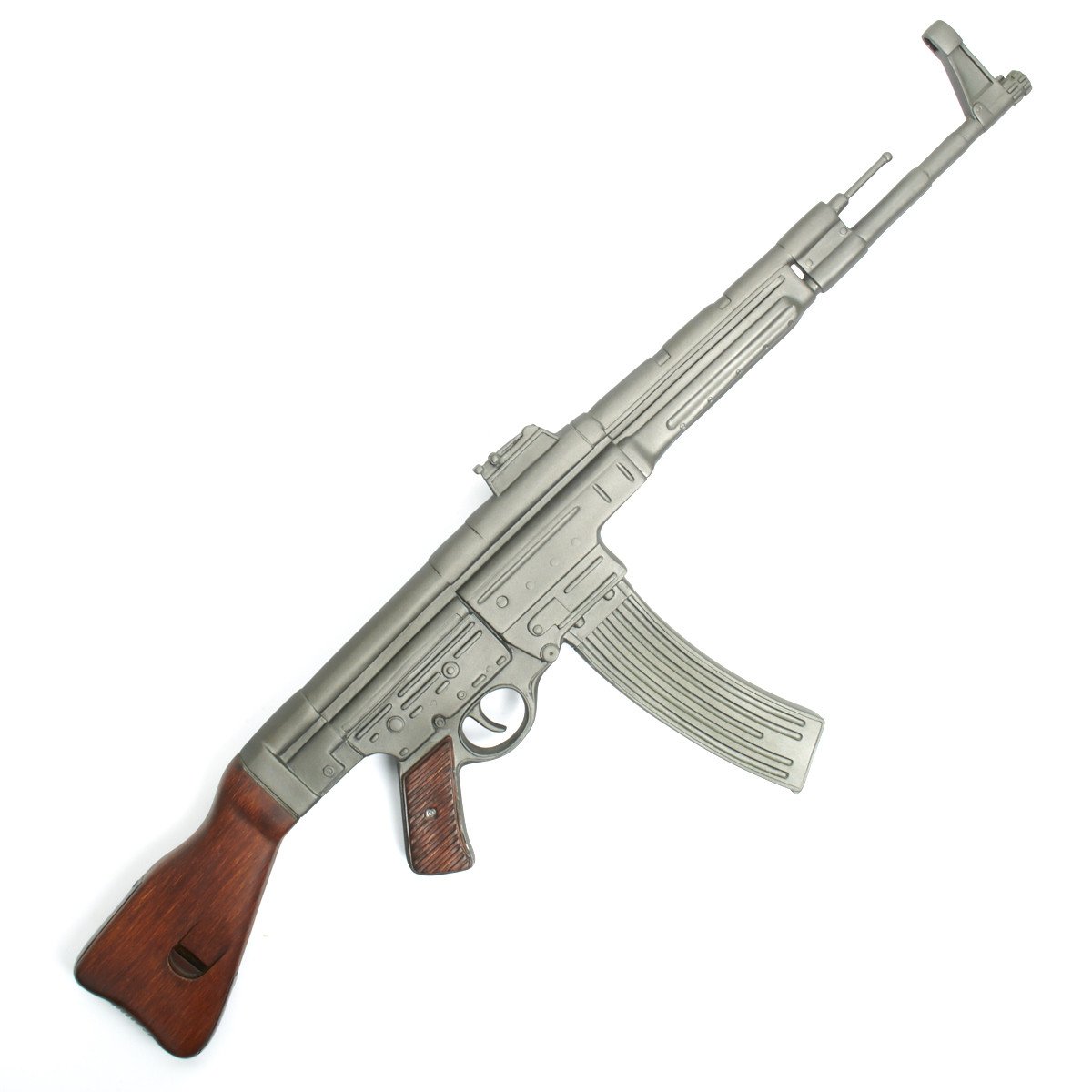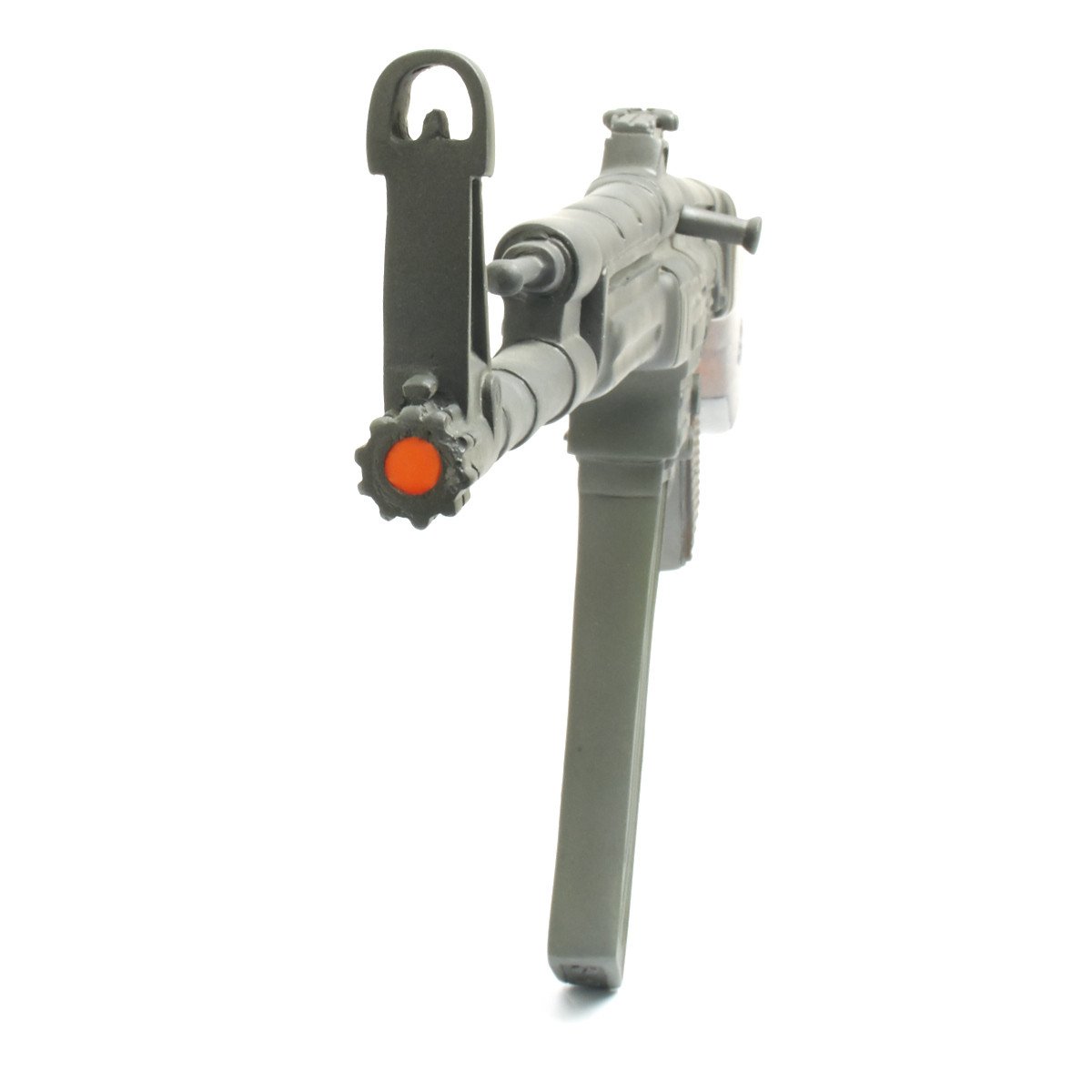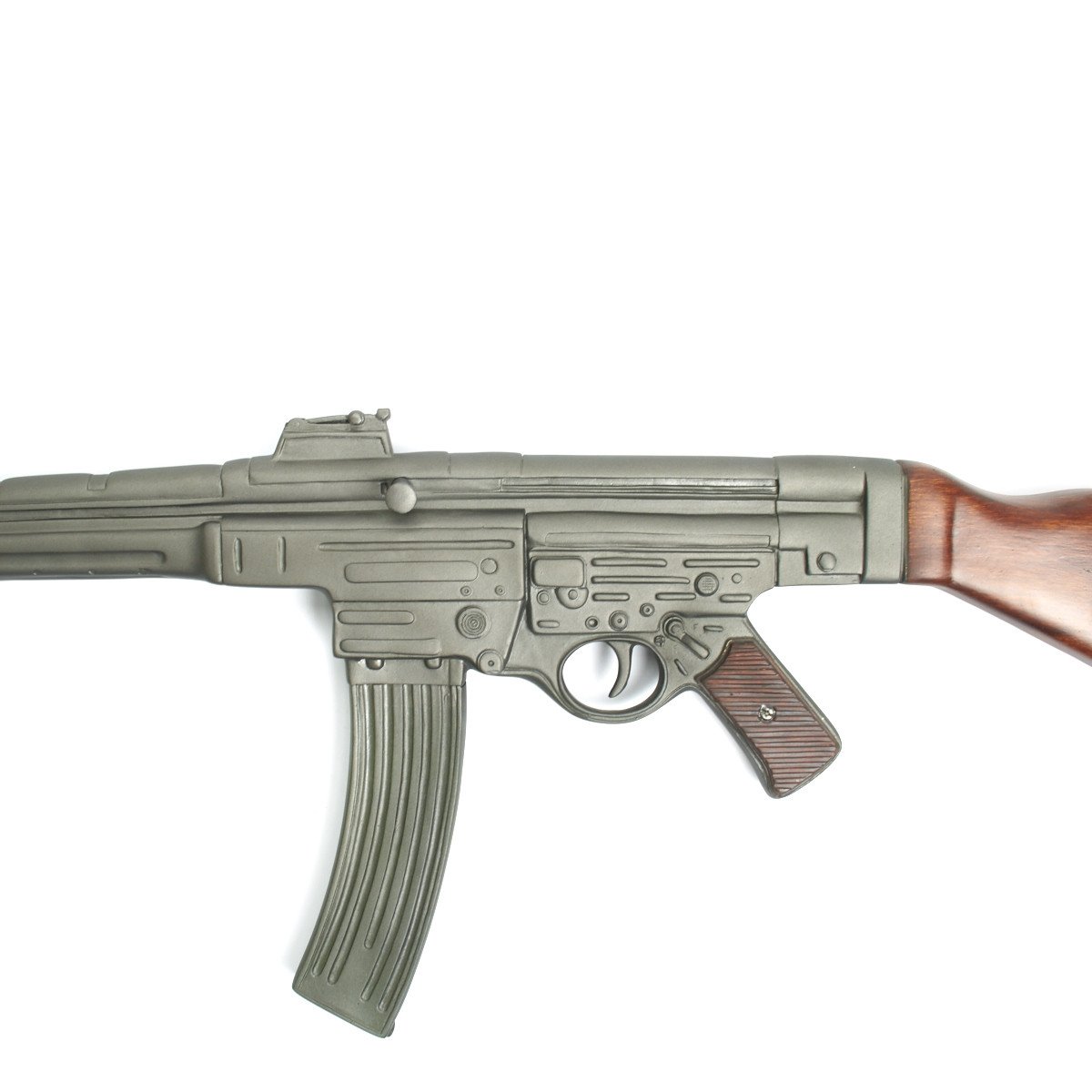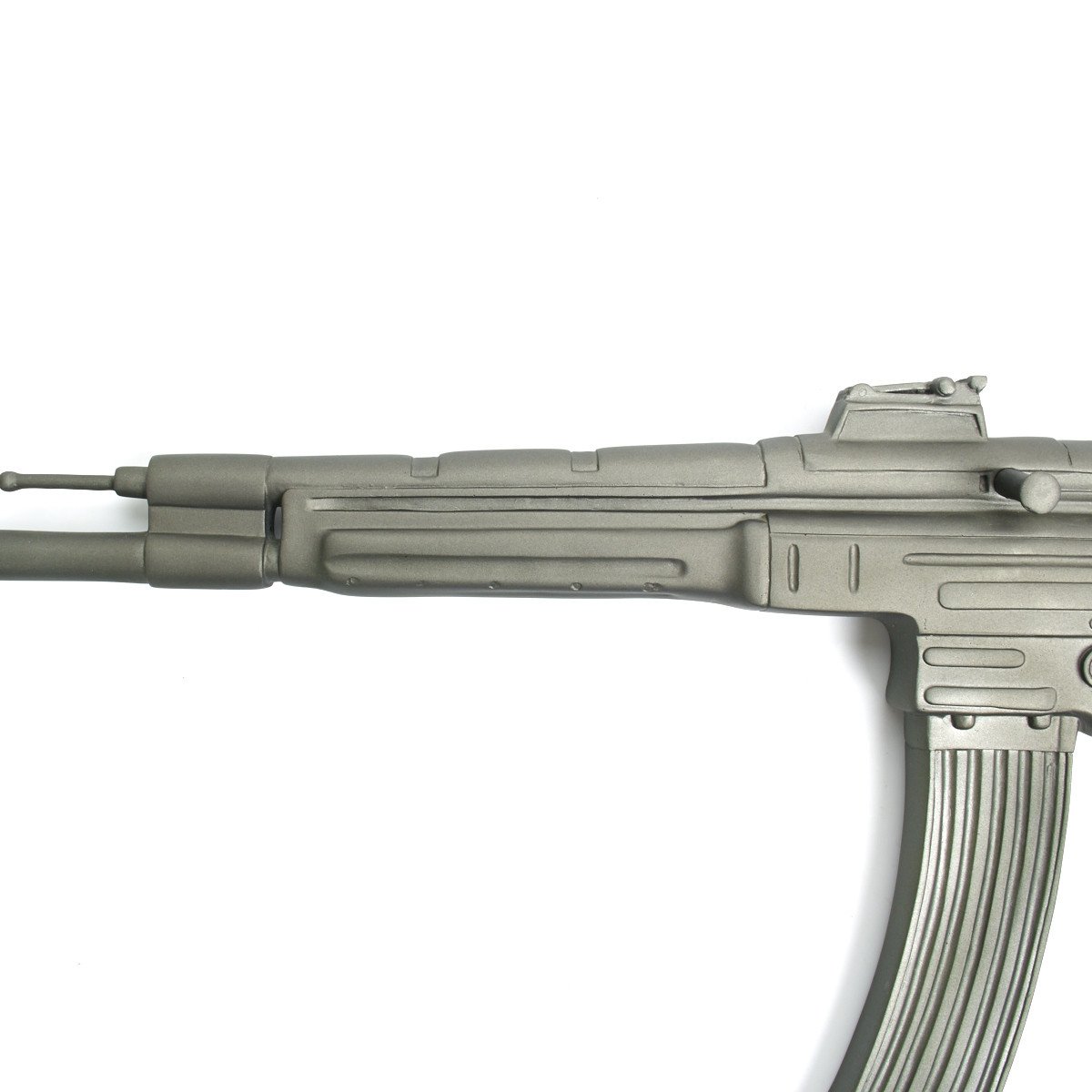German WWII MP 44 Resin Display Gun New Made Items
$ 149,95 $ 59,98
New Made Item: Our solid resin Stg44 non-firing display gun is nothing short of stunning. It really does look like the real thing from just a few feet away. It was cast from a silicon mold of an original MP44 in the IMA collection and therefore is not only an accurate 1:1 scale but has all the details of the real thing. It has been expertly air brushed to provide the cold glimmering look of steel and the warm richness of wood grips. For added sturdiness we added a metal wire frame that runs through most of the more delicate areas of the gun.
This is it, finally an affordable, safe, robust, quality display alternative to spending many thousands of dollars on a liability laden display gun. Perfect for gun enthusiasts, as a prop firearm for theatrical and film productions or one amazing childhood toy for epic war games.
Not only does it look good but it also feels good as this gun weighs a hearty 8 lbs!
History of the MP44-
The StG 44 (Sturmgewehr 44, literally “storm rifle model of 1944 was an assault rifle developed in NSDAP Germany during World War II that was the first of its kind to see major deployment and is considered by many historians to be the first modern assault rifle. It is also known under the designations MP 43 and MP 44 (Maschinenpistole 43, Maschinenpistole 44 respectively), which denote earlier development versions of the same weapon with some differences like a different butt end, muzzle nut, shape of the front sight base or with an unstepped barrel, all only visible with close inspection.
MP 43, MP 44, and StG 44 were different designations for what was essentially the same rifle, with minor updates in production. The variety in nomenclatures resulted from the complicated bureaucracy in NSDAP Germany. Developed from the Mkb 42(H) “machine carbine”, the StG44 combined the characteristics of a carbine, submachine gun and automatic rifle. StG is an abbreviation of Sturmgewehr. The name was chosen for propaganda reasons and literally means “storm rifle” as in “to storm (i.e. “assault”) an enemy position”. After the adoption of the StG 44, the English translation “assault rifle” became the accepted designation for this type of infantry small arm.
The rifle was chambered for the 7.92×33mm Kurz[6][3][7][8][9] cartridge. This shorter version of the German standard (7.92x57mm) rifle round, in combination with the weapon’s selective-fire design, provided a compromise between the controllable firepower of a submachine gun at close quarters with the accuracy and power of a Karabiner 98k bolt action rifle at intermediate ranges. While the StG44 had less range and power than the more powerful infantry rifles of the day, Wehrmacht studies had shown that most combat engagements occurred at less than 300 m, with the majority within 200 m. Full-power rifle cartridges were excessive for the vast majority of uses for the average soldier. Only a trained specialist, such as a sniper, could make full use of the standard rifle round’s range and power.
The StG 44’s receiver was made of heavy stamped and welded steel as were other contemporary arms such as the MP 40 and MG 42. This made for a fairly heavy rifle, especially one firing an intermediate-power cartridge. Difficulties with fabrication, the need to use available non-priority steels, and the exigencies of war resulted in a heavy receiver. U.S. military intelligence criticized the weight of the weapon along with the inclusion of the fully automatic feature which it considered “ineffectual for all practical purposes”, convinced that full automatic fire with StG 44 was permitted in emergencies only. This was a misinterpretation of the manual however, as the German manual states that automatic fire was “advised only in emergencies”, this was mainly to make sure that the regular soldier didn’t unnecessarily waste his ammunition spraying at targets, but instead fired in short accurate bursts to achieve maximum accuracy and effect; the StG could easily and safely be used in full automatic mode. The British were also critical saying that the receiver could be bent and the bolt locked up by the mere act of knocking a leaning rifle onto a hard floor. Many of these criticisms are more a testimonial of the Allied aversion rather than an accurate view of the weapon’s characteristics that were proven highly effective during combat in the war.
To its credit, it was the first successful weapon of its class, and the concept had a major impact on modern infantry small arms development. By all accounts, the StG 44 fulfilled its role admirably, particularly on the Eastern Front, offering a greatly increased volume of fire compared to standard infantry rifles. In the end, it came too late to have a significant effect on the outcome of the war.
Prompt Shipping and Professional Packaging
We provide a variety of shipping options due to our long-running partnerships with UPS, FedEx and DHL. Our warehouse personnel are well trained and will pack the goods according to our exact and precise specifications. Before shipping your items will be thoroughly inspected and secured. Every day, we deliver to thousands of customers in different countries. This is a sign of our determination to become the largest online retailer worldwide. Both Europe as well as the USA have warehouses and distribution centers.
Note that orders containing more than one item will be subject to a processing period that is based to the particular item.
Prior to shipping the items, our staff will carry out an exhaustive inspection of the products you ordered. Today, most orders will be delivered within 48 hours. The estimated delivery time is between 3-7 days.
Returns
The stock is constantly changing. It's not entirely managed by us since we are involved with multiple entities, including the factory and our storage. Therefore, the actual inventory could alter at any time. It is possible that you will not receive your order after the order has been made.
The period of time is 30 days. Unfortunately, if 30 days have passed since you purchased your product, we are unable to provide a refund or exchange.
The item must not be in use and must be in the original packaging. The item must be in the original packaging.
Related products
Uncategorized
Uncategorized
Angolan Rebel 1970s era 60mm Inert Display Mortar from Angolan Civil War Original Items
Uncategorized
Band of Brothers ORIGINAL GERMAN WWII Le. F.H. 18 10.5cm ARTILLERY PIECE Original Items
Uncategorized
Uncategorized
Uncategorized
Uncategorized
Uncategorized
Uncategorized
Uncategorized
Uncategorized
Uncategorized
Uncategorized
Uncategorized
Uncategorized
Uncategorized
Uncategorized
Uncategorized
Armoured Fighting Vehicles of the World: AFVs of World War One (Hardcover Book) New Made Items
Uncategorized












































































